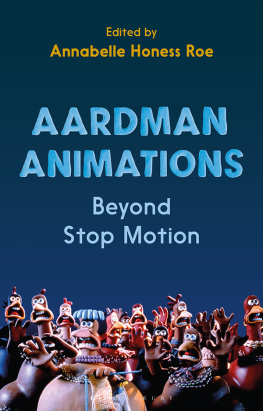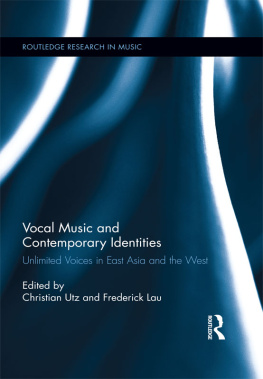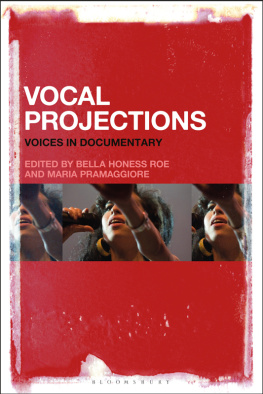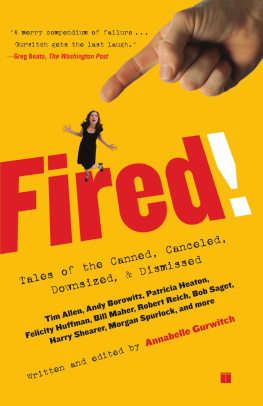Annabelle Honess Roe - Vocal Projections: Voices in Documentary
Here you can read online Annabelle Honess Roe - Vocal Projections: Voices in Documentary full text of the book (entire story) in english for free. Download pdf and epub, get meaning, cover and reviews about this ebook. year: 2018, publisher: Bloomsbury Academic Bloomsbury Publishing Inc, genre: Romance novel. Description of the work, (preface) as well as reviews are available. Best literature library LitArk.com created for fans of good reading and offers a wide selection of genres:
Romance novel
Science fiction
Adventure
Detective
Science
History
Home and family
Prose
Art
Politics
Computer
Non-fiction
Religion
Business
Children
Humor
Choose a favorite category and find really read worthwhile books. Enjoy immersion in the world of imagination, feel the emotions of the characters or learn something new for yourself, make an fascinating discovery.
- Book:Vocal Projections: Voices in Documentary
- Author:
- Publisher:Bloomsbury Academic Bloomsbury Publishing Inc
- Genre:
- Year:2018
- Rating:4 / 5
- Favourites:Add to favourites
- Your mark:
- 80
- 1
- 2
- 3
- 4
- 5
Vocal Projections: Voices in Documentary: summary, description and annotation
We offer to read an annotation, description, summary or preface (depends on what the author of the book "Vocal Projections: Voices in Documentary" wrote himself). If you haven't found the necessary information about the book — write in the comments, we will try to find it.
Vocal Projections: Voices in Documentary — read online for free the complete book (whole text) full work
Below is the text of the book, divided by pages. System saving the place of the last page read, allows you to conveniently read the book "Vocal Projections: Voices in Documentary" online for free, without having to search again every time where you left off. Put a bookmark, and you can go to the page where you finished reading at any time.
Font size:
Interval:
Bookmark:
Vocal Projections
Vocal Projections
Voices in Documentary
Edited by
Annabelle Honess Roe and Maria Pramaggiore

This project was born out of a chance conversation in 2012 and the discovery of our unexpected mutual intellectual interest in the unacknowledged significance of the voice in documentary. This planted the idea for what would become Vocal Projections: Voices in Documentary, a project that has prevailed through many life, geographical and professional changes over the intervening years. As with many things, we think this book has benefitted from its slow gestation. It has allowed us to explore and play with ideas around the voice and documentary in various contexts, including a symposium we co-convened at the University of Surrey in 2014. The book has also developed in step with a growing interest in sound, and particularly the voice, in documentary studies. The publication of this book represents a rewarding fruition of our interest in this topic and, we hope, augurs well for future developments, as our work joins other recent publications in this area.
We are indebted to the contributors to this book, who were generous with their efforts and thoughts and very patient with our editing process. In addition, we have greatly enjoyed various intellectual exchanges about the voice in documentary with colleagues far and wide at venues such as the Society for Cinema and Media Studies and Visible Evidence conferences and, most recently, as part of the stimulating stream on the documentary voice chaired by Pooja Rangan and Genevieve Yue at the 2017 American Comparative Literature Association conference in Utrecht.
Annabelle Honess Roe and Maria Pramaggiore
Vocal Projections: Voices in Documentary seeks to reconsider if not displace the primacy of the visual in documentary studies by focusing on the way documentaries engage with the sonic capacities and the semiotic implications of human and non-human voices. The vibrational, imaginative and political projections of voices, whose vague spatial anchoring (Metz 1980: 29) enables them to be coupled with and decoupled from bodies and images, endow them with complex signifying possibilities. The key concerns of this book echo questions raised by Christian Metz in Aural Objects, where he contends that the Western understanding of sound as a secondary quality a non-object leads to a tendency to neglect its own characteristics in favor of those of its corresponding substance, which in this case is the visible object, which has emitted the sound (1980: 30).
The scholarly disregard for the characteristics of sound in film and media studies that Metz identified in 1980 has been redressed in the ensuing decades by the work of Rick Altman, Claudia Gorbman, Anahid Kassabian, Michel Chion, Michael Bull and Les Back, Jean-Luc Nancy, Jay Beck and Tony Grajeda, Jonathan Sterne, Liz Greene and Danijela Kulezic-Wilson, among many others. Amid the sonic turn that has informed film and media studies scholarship, however, only a few works devote their main attention to documentary sound, including Gunnar Iversens and Jan Ketil Simonsens Beyond the Visual: Sound and Image in Ethnographic and Documentary Film (2010) and Holly Rogerss Music and Sound in Documentary Film (2015), and only Pooja Rangans and Genevieve Yues recent special issue of Discourse (2017) specifically examines the voice.
Vocal Projections was prompted by what seemed to us to be this glaring and even inexplicable omission: although the concept of the voice occupies a central position within documentary film and media studies, voices have never fully been given their due. Vocal metaphors dominate the field, having emerged from Bill Nicholss early discipline-defining essay, The Voice of Documentary (1983), which frames the voice of documentary as a rhetorical sensibility that presents a films social point of view (1983: 18). In Representing Reality (1991) and Speaking Truths with Film (2016), Nichols continues to marshal metaphors that equate voice with argument and point of view. Nicholss most recent characterization of the voice of documentary is as a Hey You that attempts to speak to us about the world we share (2016: 72). However, the chapters in this book collectively argue that by examining the implications of documentary filmmakers and audiences treating the human voice as a substance we can productively move beyond the conflation of voice and the sense-making imperatives of language that has dominated documentary studies. As such, each of the sixteen chapters in Vocal Projections considers the ways that documentaries attend to and exploit the attributes of voice by paying attention to the sonic principles, audio techniques and structural choices that filmmakers employ in their documentary treatment of recorded voices.
Nicholss conceptualization of the voice of documentary as a framework for delivering a social or political point of view comports with a long intellectual history beginning with Aristotle and continuing through Heidegger that understands the voice as an instrument of rational and intentional human communication. The notion that the voice offers access to a stable subjectivity has been questioned within post-structural and postmodern theory, notably by Roland Barthes, Jacques Derrida, Gilles Deleuze and Mladen Dolar. With the exception of Dolar, however, these theorists are more interested in challenging the coherence of the subject than in exploring the voice per se. Moving beyond ideas about individual identity, philosopher Adriana Cavarero and social theorist Nick Couldry highlight the voice as a site of political subjectivity, a means for asserting unique standpoints and establishing shared narratives that foster collective action.
Taking up Nicholss metaphorical conception of the voice, most studies of documentary have explored the voice in terms of its evidentiary, truth telling, rhetorical, persuasive and authenticating functions. The most significant challenge to Nicholss paradigm within documentary studies has emerged from postcolonial and feminist scholars, many of whom retain an understanding of the voice as a medium for political representation while mounting a critique of documentarys desire to speak for the underrepresented, the marginalized and the oppressed. Gayatri Spivak, Trinh T. Minh-ha, Fatimah Tobing Rony and Brenda Longfellow, among others, have indicted ethnographic documentary for reproducing colonial hierarchies, pointing to practices such as subtitling and dubbing that paternalistically objectify the people whose point of view documentary purports to be enabling. In particular, Trinhs influential concept of speaking nearby has been taken up as an ethical intervention to reconfigure the power dynamics that inevitably result from the practice of speaking for others.
Vocal Projections does not seek to reject the fruitful insights that have emerged from the metaphorical conceptualization of the voice that treats it as a rhetorical and political instrument. Rather, we intend to augment this way of understanding the voice of documentary with an examination of voices in documentary. We believe that our shift in emphasis bears important implications. That voices are always specific rather than generic was implied by Asif Kapadia when asked why he chose not to use voice-over in Amy (2015). His response that I didnt want to use voiceover; I mean, who would I use? (2016) suggests that this narrational technique is always informed by the acoustic effects and the social and political associations conveyed by a specific voice. Similarly, Stevan Rileys Listen to Me Marlon (2015), which draws from Marlon Brandos extensive private audio archive of interviews, home movies and informal verbal musings, foregrounds the complex relation between documentary voices and subjects. An exercise in volubility and immediacy, the films intensely materialist engagement with Brandos voice reminds us of the limitations of ascribing a singular metaphorical understanding to documentary voice. Instead, as this book reflects, documentarys many voices are linked to both visible and implied bodies in a variety of ways and may serve to shore up or authenticate as well as to deconstruct identities.
Next pageFont size:
Interval:
Bookmark:
Similar books «Vocal Projections: Voices in Documentary»
Look at similar books to Vocal Projections: Voices in Documentary. We have selected literature similar in name and meaning in the hope of providing readers with more options to find new, interesting, not yet read works.
Discussion, reviews of the book Vocal Projections: Voices in Documentary and just readers' own opinions. Leave your comments, write what you think about the work, its meaning or the main characters. Specify what exactly you liked and what you didn't like, and why you think so.













